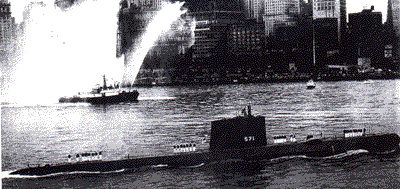 |
FAMOUS SHIPS |
 |
FAMOUS SHIPS |
The USS NAUTILUS
I thought it would be interesting to
highlight an area that has not been covered previously in the SMA newsletter
submarines (at least by articles). What
better submarine to start with than the USS Nautilus.
She is 323.8 feet long, 27.7 feet broad, and 22 feet deep with a tonnage
of 3,533/4,902 disp. She was
armed with 6 X 21 torpedo tubes. She
was nuclear powered with a steam turbine, 13,200 shp, 2 screws; 23 knots.
She was built by the Electric Boat Co., Groton, Connecticut in 1955.
She was basically the brainchild of
Hyman G. Rickover, who eventually became an admiral in the U.S. Navy.
The chief advantage of the nuclear powered submarine is that it produces
heat to create steam through fission rather than fire resulting in no
requirement for oxygen. This means
that the USS Nautilus can stay submerged for an almost indefinite amount of
time. There is also the added
benefit of space saved from not having to store fuel aboard the space
required to store the uranium for the ship is minimal, since she only requires
about one pound of material thus much more space for the crew and weapons.
The USS Nautilus was launched by First
Lady Mamie Eisenhower on January 21, 1954.
She became the first nuclear powered ship in the United States Navy on
September 30, 1954. Under her first
Commanding Officer, Commander Eugene P. Wilkinson, USN, she cast off her lines
on January 17, 1955 and got Underway On Nuclear Power.
She subsequently shattered all submerged speed and distance records held
up to that time.
On July 23, 1958, USS Nautilus departed
Pearl Harbor, Hawaii to conduct Operation Sunshine, a top-secret voyage under
the North Pole. With her second
Commanding Officer, Commander William R. Anderson, USN, she became the first
submarine to accomplish the impossible, reaching the geographic North Pole
90 degrees north with 116 crew aboard.
For this feat she was awarded the Presidential Unit Citation the
first ship to receive this award in peace-time.
Her next career move was to be the
first submarine assigned to the Sixth Fleet in the Mediterranean.
She was used extensively in the development of new antisubmarine warfare
techniques since she was the first nuclear submarine. In 1962 she took part in the blockade during the Cuban
Missile Crisis and later operated with the Second Fleet. During her operational lifetime, the USS Nautilus covered
more than 300,000 miles using only three nuclear cores. She was decommissioned in 1980.
The USS Nautilus was designated a
National Historic Landmark by the Secretary of the Interior on May 20, 1982. She subsequently joined the Submarine Force Museum on April
11, 1986, where she can be viewed today as part of the Nautilus Memorial and
Submarine Force Library and Museum in Groton, Connecticut.